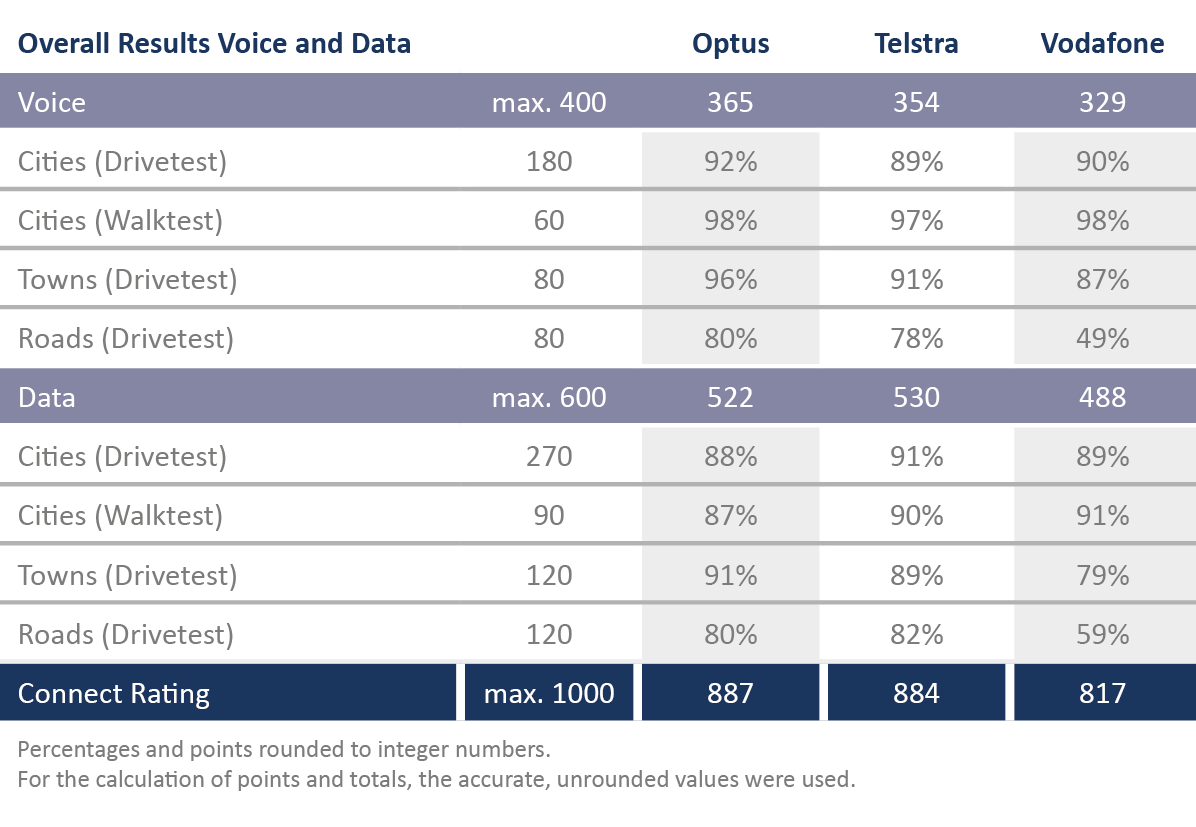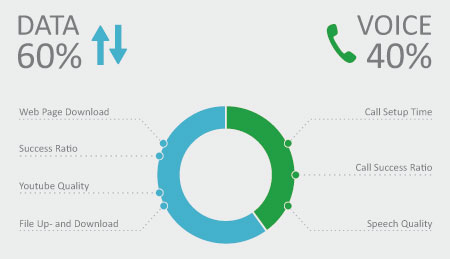The benchmarking expert P3 communications has been testing the mobile network performance in Australia since 2014. Now, for its fourth mobile network test in Australia, P3 teams up with the internationally acknowledged telecommunications magazine connect. This combines P3’s longtime network benchmarking expertise with decades of connect’s editorial experience. Together, we have carefully examined the performance and quality of the mobile networks in Australia.
RESULTS IN A NUTSHELL
It was a neck-and-neck race of the two largest Australian operators. This year, Optus takes the “best in test“ accolade from an also “very good“ Telstra. Vodafone confirms its position from the previous test, receiving the grade “good“ and catching up further.
P3‘s network benchmarks are widely accepted for setting industry standards as well as being highly objective. The carefully designed methodology scheduled four drivetest cars to visit nine large Australian cities and 19 smaller towns as well as the connecting roads between them. In addition, two teams conducted walktests in four large cities. The areas in which we tested account for more than 13.7 million people, or about 61 per cent of Australia‘s population.
Another example for P3‘s great attention to detail is the use of up-to-date LTE “Cat 9“ as well as VoLTE-capable smartphones for the tests. They reflect the latest technical developments in the mobile networks and once more emphasise the scope of our benchmarking: How do the mobile networks perform at the edge of what is technically feasible – and to what extent do customers benefit from these capabilities? In order to provide valid answers to these questions, we have also used the most comprehensive mobile plans available from each operator. Also, we constantly readjust the thresholds of our evaluation to represent the latest technological advancements.
The pleasant results of P3‘s previous mobile network benchmarks in Australia have set high expectations. In fact, all three operators were able to meet them – Optus and Telstra managed to distinctly improve their scores, and Vodafone confirmed its position by gaining five points over last year‘s result.
Optus wins due to lead in voice, Telstra scores best in data
It was a neck-and-neck race of the two biggest Australian operators. Ultimately, Optus won with an advance of three points over Telstra. Both receive the grade “very good“. Optus secures its overall win with a clear lead in the voice category, while Telstra scores best in the data discipline. Vodafone ranks third, scoring behind the leading two both in voice and data. Still, Vodafone performs decently and gains the overall grade “good“.
Australia’s operators
The Australian mobile communications market is served by three operators that clearly differ in terms of market shares. All three of them offer the latest mobile technologies like LTE-Advanced and VoLTE
According to its own statement, Telstra currently has 17.4 million mobile subscribers. This makes this operator market leader in Australia.
The history of Telstra dates far back: The company originated as part of the Postmaster-General‘s Department and was fully privatised by 2006. The last remaining government share was effectively sold in 2011. Today, Telstra offers voice, mobile and internet access, as well as Pay TV and other entertainment services to Australian customers.
The operator provides 3G (UMTS) services at 850 and 2100 MHz and a 4G (LTE including LTE-Advanced) network on the 700, 900, 1800 and 2600 MHz frequency bands. Like its competitors, Telstra has been continually increasing its LTE coverage and offerings, now providing LTE-Advanced under the name “4GX“ and claiming a 4G coverage of 99 per cent of the Australian population.
With reportedly 9.8 million mobile subscribers, Singtel Optus is the second largest mobile operator in Australia.
The company was originally founded as AusSat in 1981 and later changed its name to “Cable & Wireless Optus“. Since 2001, it is a wholly owned subsidiary of the Singapore-based SingTel. The company offers its mobile services mainly under the brand name Optus, but also maintains a number of subsidiary brands, such as Virgin Mobile Australia. Its offerings span fixed and mobile telephony and data networks, broadband access for both consumers and business customers, cable TV and satellite services.
Optus provides a 3G network at 900 and 2100 MHz and 4G/LTE at the 700, 1800, 2100, 2300 and 2600 MHz bands. Its 4G offerings include LTE-Advanced under the brand name “4G Plus“. As of November 2017, the company claims to cover 96 per cent of Australians with its 4G/LTE service.
Vodafone Australia quotes a subscriber base of approx. 7 million mobile customers. This makes Vodafone Australia‘s third largest mobile operator.
The current company was formed in a merger of Vodafone Australia and Hutchison 3G Australia (and its former “3“ network) in 2009. As an indication to its two owners each holding a 50 per cent share, the company is often referred to as “VHA“ (Vodafone-Hutchison Australia). Today, it offers a full suite of mobile and fixed networks and access products.
The joint company offers 2G at 900 MHz, 3G at 900 and 2100 MHz as well as 4G at 850, 1800 and 2100 MHz. Upgrading and expanding its 4G service, Vodafone enabled carrier aggregation on all of their 4G bands which is part of the LTE-Advanced specification.
The company claims to cover “over 22 million” Australians. According to Vodafone, its 4G network reaches 96 per cent of the population in metropolitan areas.
A closer look at Australia’s networks
Over the past years, all operators in Australia have shown continuous improvements which reflected in our network tests. We are happy to report the trend persists in 2017.
The German company P3 is a world leader in mobile network testing. It is part of the P3 group, with over 3000 employees worldwide and a turnover of more than 300 million Euros (468 million Australian Dollars).
In 2017, P3 runs its authoritative mobile network benchmark in Australia for the fourth time. In 2017, this is realised for the first time together with the international telecommunications magazine connect for its network test in Australia. The magazine has more than 20 years of editorial experience and is one of the leading test authorities for telecommunications products and services in the world. Together, P3 and connect have been conducting mobile network benchmarks in Europe for more than 15 years.
In 2016 alone, P3 compiled more than 60,000 measurement hours in 65 countries across five continents, with its test vehicles covering almost one million kilometres.
As the de-facto industry standard, the P3 benchmarking methodology focuses on customer-perceived network quality – examining both voice telephony as well as data connectivity. P3‘s network benchmarks are widely accepted as an objective authority.
Clear improvements in 2017
As in the years before, we have taken great effort to provide an objective view on the performance and quality of the Australian mobile networks. Without trying to get ahead of the detailed results, we are happy to assert that all three Australian operators were able to improve their scores over the previous test.
Hakan Ekmen, Managing Director of P3
“The P3 connect Mobile Benchmark Australia shows that Australia’s network operators are continously improving. The ongoing investments on upgrading and expanding their networks to meet customer demand let the market develop more and more towards an outstanding performance. This year, Optus gains the victory for the first time.”









